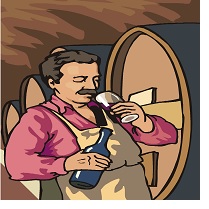

|
Understanding Wine
Cooked, Corked, and Other Problems Glossary of Wine Good Grapes Make Good Wine Grading and Tasting Wine Home Winemaking Selecting a Fine Wine Serving Wine Storing Beer Vs. Wine |
The Hobby of Wine - Part Art, Part Science and Sometimes All Business One of the earliest activities of agricultural societies, in one manner or another, the production of wine has been carried out for thousands of years by many different societies. One of the earliest activities of agricultural societies, in one manner or another, the production of wine has been carried out for thousands of years by many different societies.
Pottery which has been discovered in Persia (The modern country of Iran.), which has been dated at 5,500 BC, shows evidence of grape use for winemaking. Not surprisingly, jars, which have been dated to between 6000 and 7000 BC, from Jiahu in China, have been found still containing wine from wild grapes. Whether ancient or modern, many of the same conditions are required and similar techniques used now as then. The chemistry of grapes is eternal. Wine grapes grow, with few exceptions, only in latitudes 30-50 degrees North and 30-45 degrees South of the equator. Unlike most crops, grapes don't require fertile soil. The thinness of the soil restricts the quantity of the crop, producing fewer grapes of higher quality. Paradoxically, soils which are too rich in nitrogen and other nutrients...elements highly beneficial for most plants...can produce grapes unsuitable for winemaking. Fine for eating, but lacking desirable quantities of minerals, sugars and acids. One obscure fact which always seems to amaze the newcomer to wines and wine making is that the best wines are produced from soil that would be considered poor quality for other agricultural purposes. The stellar wines from Bordeaux are made from grapes grown in gravelly soil, atop a base of clay or chalk. Fewer grapes are grown, but high in quality. The pebbly earth allows for good drainage grapevines require access to adequate, but not excessive, water. As the roots reach down further, more complex minerals are absorbed. Vineyards are most often founded in river valleys, on slopes that provide abundant sunshine. Vines there are most often of the European species vitis vinifera, from which many common wines are made, such as Chardonnay, Cabernet Sauvignon, and Merlot. Viticulture, the technical term for the practice of growing grapes for wine, is today one of the most complex agricultural undertakings. A master vintner (today, sometimes called an oenologist), must be an expert in soil chemistry and fermentation, climatology and several other ancient arts and modern sciences. In addition to categorization by variety, the products of these vines are classified by vinification methods - sparkling, still, fortified, rosι, blush or by region Bordeaux, Burgundy and Alsace, for example and, of course, by vintage, as well as a dozen other methods. After the farmer, chemist and manufacturer have had their say, the businessman must take over. In 2002, 595 million gallons of wine were sold in the U.S. alone, representing over $20 billion in consumer spending. France led the pack with 22% of export volume, with Italy a close 20% behind. The bold artists of wine must possess a sensitive nose and palette and balance dozens of time-sensitive factors such as when to harvest, how long to ferment and age, when to bottle. And that's before considering modern manufacturing and marketing requirements, not to mention today's legal restrictions on almost all things, including the fruit of the vine. Part art, part science, and, perhaps, part business, viticulture is a hobby which is definitely not for the timid. |
More Wine Websites and Resources Build Your Own Wine Cellar Wine Cellar Software |
More Hobbies
The Hobby of Wine - Copyright 2018 by Donovan Baldwin
Page Updated 1:45 PM Monday 15 October 2018